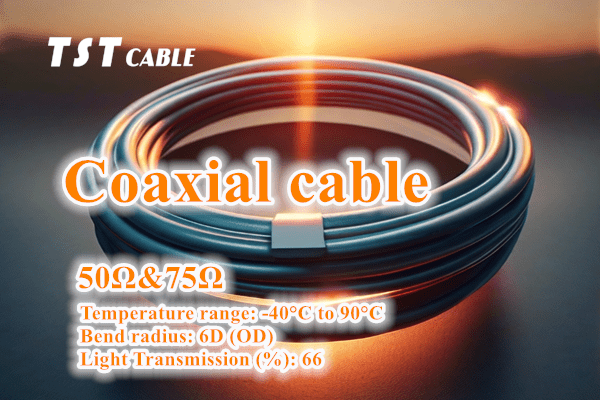Are you wondering whether your equipment should use coaxial cable or twisted pair? What are the characteristics of coaxial cable and twisted pair technology and applications?

There are significant differences in structure, purpose and performance between coaxial cable and twisted pair. Below TST CABLES will explain in detail the differences, advantages and disadvantages between coaxial cable and twisted pair.
Coaxial Cable
Construction: Coaxial cable consists of a center conductor (usually solid or braided copper wire) surrounded by a layer of insulation, followed by a shield (usually metal mesh or foil), and an outer protective jacket.
Purpose: Mainly used for television signal transmission, broadband Internet access (such as Cable Modem), radio communications, and analog and digital signal transmission.
Subdivision of coaxial cable
RG type coaxial cable: This is a common type of coaxial cable that is widely used for television signal transmission in homes and businesses, as well as in some radio communications applications. Different models (such as RG-6, RG-59) are suitable for different frequency ranges and transmission distances.
LDF type coaxial cable: This type of cable is commonly used for long-distance telephone lines and broadcast services. It has lower signal loss characteristics and is suitable for long-distance signal transmission.
Microwave coaxial cable: specially designed for microwave frequencies and used in high-frequency applications such as radar, satellite communications and microwave relay stations, which require higher shielding efficiency and lower signal attenuation.
Advantages of coaxial cable:
Able to maintain signal quality over longer distances and have higher bandwidth.
The shielding layer provides better anti-interference ability.
Can support high frequency signal transmission.
Disadvantages of coaxial cable:
It is relatively thick, difficult to bend, and may not be flexible enough when installed.
The cost may be higher relative to twisted pair.
There will also be attenuation of the signal over very long distances.
Twisted Pair Cable
Structure: Twisted pair wire consists of two insulated copper wires tightly twisted together. Sometimes multiple pairs of such twisted wires are enclosed in a jacket. Common types include UTP (unshielded twisted pair) and STP (shielded twisted pair).
Purpose: Mainly used for data transmission in local area networks (LAN), such as Ethernet connections, telephone lines, and some monitoring systems.
Types and applications of twisted pairs
Unshielded Twisted Pair (UTP): No external shielding, lower cost, suitable for most LAN applications. According to the transmission speed and signal quality, it can be divided into multiple categories, such as Cat5, Cat5e, Cat6, Cat6a, Cat7, etc.
Shielded twisted pair (STP): Each pair of wires has its own shielding layer, and the entire cable also has a general shielding layer, which provides better anti-interference capability and is suitable for environments with high signal integrity requirements, such as industrial control networks and security monitoring systems.
Shielded Twisted Pair (SFTP): Each pair has independent shielding and is suitable for high-frequency signal transmission, such as high-speed data networks.
Advantages of twisted pair:
The cost is relatively low and easy to install and maintain.
The twisted design helps reduce crosstalk between signals and external electromagnetic interference.
Over short distances, adequate data transfer rates can be provided.
Disadvantages of twisted pair:
Compared with coaxial cables, twisted pair cables have limited transmission distance and bandwidth.
For long-distance and high-frequency signals, signal attenuation and interference problems are more obvious.
Technology Development Trends of Coaxial Cables and Twisted Pairs
Coaxial Cable: Although replaced by fiber optic and twisted pair in some areas, coaxial cable continues to evolve, for example, through improved materials and design, increasing bandwidth and transmission efficiency to accommodate the needs of high-definition video and high-speed Internet.
Twisted pair: With the development of Ethernet technology, twisted pair is moving towards higher data transmission rates. The emergence of standards such as 10GBase-T and 25GBase-T enables twisted pair to be used in a wider range of scenarios. Replaces fiber optic and coaxial cables.
Application areas: Coaxial cables are suitable for applications requiring higher bandwidth and longer transmission distances, such as radio and television signal transmission. Twisted pair cable is more commonly used in local area networks, telephone systems, and some surveillance systems, especially in short-distance and cost-sensitive applications.
Technical characteristics: Coaxial cable provides better signal isolation and shielding effects and is suitable for high-frequency signal transmission; twisted pair cable relies on twisted design to reduce crosstalk and is suitable for short-distance transmission of medium and low-frequency signals.
Future Development: Although twisted pair has replaced coaxial cable in many areas, especially in data networks, coaxial cable still plays an important role in certain applications, such as CATV and satellite communications. At the same time, with the development of technology, twisted pairs are constantly improving to adapt to higher data transmission rates and more complex network requirements.
Cooperated with Chinese cable manufacturer TST CABLES to customize high-quality coaxial cables and twisted pairs
Coaxial cables and twisted pairs each have their own advantages and play an irreplaceable role in different application scenarios. As technology advances, both are constantly being optimized to meet changing market demands. Chinese high-temperature cable manufacturer TST CABLES reminds everyone that when choosing the appropriate cable type, you should consider transmission distance, bandwidth requirements, cost budget, installation environment and other factors to ensure the best performance and economic benefits. Relying on exquisite craftsmanship and innovative technology, TST CABLES strives to create coaxial and twisted pair series to seamlessly connect to the digital world. Coaxial cables provide a robust signal that spans time and space, providing worry-free high-definition audio and video; twisted pair cables provide excellent anti-interference and transmit data signals at the speed of light, allowing you to enjoy free communication over the network.
Also available in:
English



